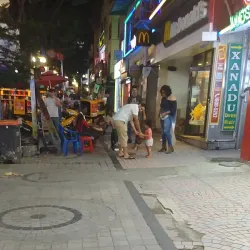Quality of life in Pyeongtaek
Pyeongtaek, located in the heart of South Korea, is a city that beautifully blends traditional Korean culture with modern advancements. Known for its strategic location, Pyeongtaek is a hub of economic activity, particularly in the manufacturing and logistics sectors. The city is home to a diverse population, including a significant number of expatriates, which adds to its multicultural vibe.
In recent years, Pyeongtaek has seen rapid development, driven by its proximity to major urban centers like Seoul and Incheon. This growth has brought about improvements in infrastructure, making it an attractive destination for both businesses and tourists. The city's unique charm lies in its ability to offer a peaceful suburban lifestyle while being close to the bustling energy of South Korea's capital.
History and Culture
Pyeongtaek's history dates back to ancient times, with archaeological findings indicating settlements from the Bronze Age. Over the centuries, it has played a significant role in Korea's history, serving as a strategic military location during various dynastic periods. The city's historical significance is further highlighted by its proximity to the ancient Baekje Kingdom, one of Korea's Three Kingdoms.
Culturally, Pyeongtaek is a melting pot of traditions and modern influences. The city hosts numerous cultural festivals throughout the year, celebrating everything from traditional Korean music and dance to contemporary arts. Notable cultural institutions include the Pyeongtaek International Exchange Foundation, which promotes cultural exchange and understanding.
The presence of U.S. military bases in the area has also contributed to a unique cultural blend, with American influences visible in local cuisine, events, and daily life. This multicultural environment is reflected in the city's diverse culinary scene, which offers a wide range of international and traditional Korean dishes.
Things to do in Pyeongtaek
Visitors to Pyeongtaek can enjoy a variety of activities and attractions. The city is known for its beautiful parks and natural landscapes, such as the Pyeongtaek Lake, which offers opportunities for boating and picnicking. For those interested in history, the Pyeongtaek Museum provides insights into the region's rich past.
Cultural enthusiasts will appreciate the city's vibrant arts scene, with venues like the Pyeongtaek Arts Center hosting regular performances and exhibitions. The city's shopping districts offer a mix of traditional markets and modern malls, providing a unique shopping experience.
Food lovers can explore Pyeongtaek's diverse culinary offerings, from traditional Korean barbecue to international cuisine. The city's annual festivals, such as the Pyeongtaek Port Festival, showcase local culture and provide entertainment for all ages.
See top attractions and things to do in PyeongtaekQuality of Life Rankings
The Quality of Life Rankings for South Korea reflect how livable a city in South Korea is. It considers factors like purchasing power, pollution, housing affordability, cost of living, safety, healthcare, commute times, and climate. A higher index score means a better quality of life.
Weather in Pyeongtaek
Pyeongtaek, South Korea experiences a humid continental climate characterized by four distinct seasons with hot, humid summers and cold, dry winters. The city receives an average annual precipitation of approximately 50 inches (1270 mm), with July being the wettest month, averaging around 14 inches (356 mm) of rainfall.
Seasonal Breakdown
- Spring (March to May) - Temperatures gradually rise from an average high of 52°F (11°C) in March to 73°F (23°C) in May. Rainfall increases during this period, with May receiving significant precipitation, averaging around 4 inches (102 mm).
- Summer (June to August) - The hottest months, with average highs ranging from 82°F (28°C) in June to 86°F (30°C) in July. Rainfall is highest in July, averaging around 14 inches (356 mm) due to the monsoon season.
- Autumn (September to November) - Temperatures gradually decrease from an average high of 77°F (25°C) in September to 54°F (12°C) in November. Rainfall remains moderate, averaging around 3 inches (76 mm) per month.
- Winter (December to February) - The coldest period, with average highs ranging from 41°F (5°C) in December to 37°F (3°C) in February. Snowfall is minimal, averaging about 2 inches (51 mm) in January.
Notable Weather Events
- Summer monsoon season with heavy rainfall in July.
- Occasional typhoons affecting the region during late summer.
- Cold snaps during winter with temperatures occasionally dropping below freezing.
Pyeongtaek's Political Climate
Pyeongtaek, located in South Korea, is a city that has seen significant political and economic development over the years. As a key hub for both domestic and international activities, Pyeongtaek's political climate is shaped by its strategic importance, particularly due to its proximity to major U.S. military bases. This has influenced the city's governance and policy-making, often aligning with national security interests and international diplomacy.
The city's political history is marked by its rapid industrialization and urbanization, which have been central themes in its governance. Current political leadership in Pyeongtaek focuses on balancing growth with sustainability, addressing issues such as urban planning, environmental conservation, and public transportation. The city has been proactive in implementing progressive policies, including initiatives aimed at reducing carbon emissions and enhancing public welfare.
Pyeongtaek's political climate is also characterized by its efforts to foster social cohesion and economic resilience. The local government has prioritized policies that support technological innovation and economic diversification, reflecting a broader national trend towards a knowledge-based economy. Recent political events have included discussions on enhancing local autonomy and improving civic infrastructure, which are crucial for accommodating the city's growing population.
Political Quick Facts
- Kim Yong-hwan - Current Mayor known for his focus on sustainable development and economic growth.
- Lee Ji-eun - City Council member advocating for social welfare and education reforms.
- Park Min-soo - Influential local politician with a strong stance on environmental issues.
Quick Facts
"Key Takeaways"
Pyeongtaek is a rapidly growing city with a strong economy driven by manufacturing and logistics.
The city offers a unique blend of traditional Korean culture and modern influences, making it a vibrant place to live and visit.
Pyeongtaek's strategic location and improved infrastructure make it an attractive destination for businesses and tourists alike.










